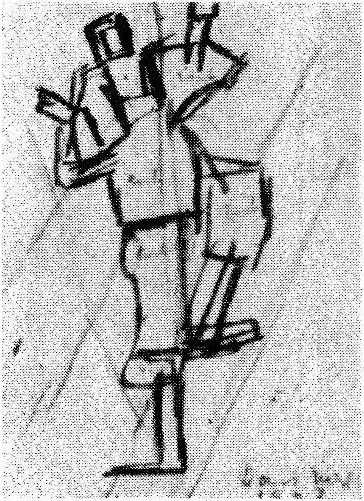Description
The work "Study of rhythm of a Russian dance" by Theo Van Doesburg, created in 1918, is located in an artistic context where European avant -garde experimented with abstraction and movement. Van Doesburg, co -founder of the Stijl movement, is known for its approach to geometry and color, and this painting can be seen as an exploration of those principles through dance, a theme that evoked both dynamism and rhythm.
At first glance, the work presents a composition characterized by geometric shapes that suggest a rigorous order, however, when observing more carefully, you can glimpse a sense of movement that invites the viewer to perceive something beyond the mere disposition of the forms . The use of vibrant and intense red, yellow and blue colors provides vivacity to the piece and suggests the energy inherent in dance. This chromatic choice, common in Van Doesburg's work, not only creates an immediate visual impact, but also plays with the emotion of the work, evoking sensations of joy and vitality.
As for the figure of the characters, it is appreciated that this work does not display explicit figurative representations, which is consistent with Van Doesburg's abstract style. Instead of delineating individualized dancers, the forms in their composition could be interpreted as abstract representations of the movements and the choreography of a dance. This reflects the influence of Futurism and the interest of Van Doesburg in capturing the feeling of movement through abstraction. Here, the visual rhythm becomes a dance parallelism, where the viewer can almost feel the cadence and flow of the movements.
The work is not only a manifestation of the influence of Cubism and futurism, but also inscribes the search for Van Doesburg for a visual language that will prioritize the purity of form and color. This search is evidenced in its style, which seeks the dematerialization of physical objects in favor of the idea and pure expression. The "rhythm study of a Russian dance" thus becomes a testimony of the intersection between dance, rhythm and visual structure, where each element is articulated with the other to generate a sensory experience.
In summary, "Russian dance study" is more than a painting; It is an interpretation of the encapsulated movement and energy in abstract shapes and vibrant colors. The work can be understood as an approach to the relationship between dance and painting, where Van Doesburg manages to transfer the essence of movement to a static surface, inviting the viewer to participate in a visual dialogue that transcends the limitations of traditional media. This exercise of invention and exploration resonates not only in the context of its time, but also remains relevant in the discussion about abstraction and contemporary art.
KUADROS ©, a famous paint on your wall.
Hand-made oil painting reproductions, with the quality of professional artists and the distinctive seal of KUADROS ©.
Art reproduction service with satisfaction guarantee. If you are not completely satisfied with the replica of your painting, we refund your money 100%.

